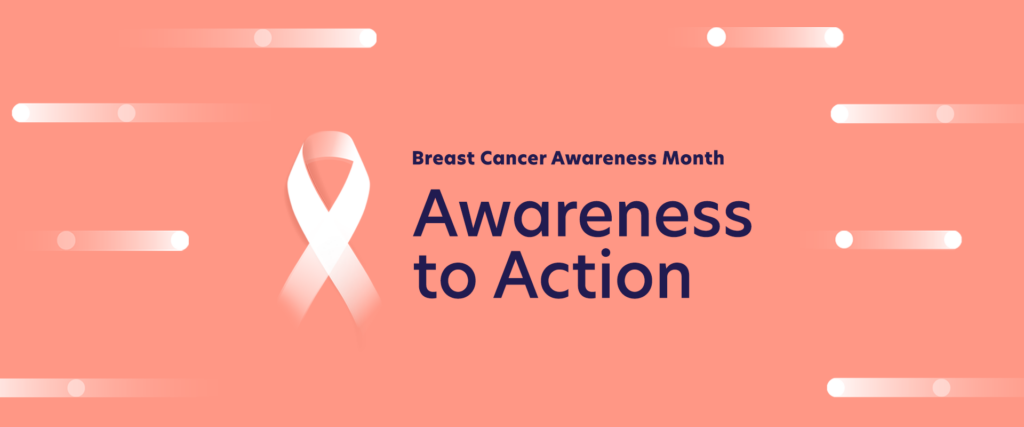News & Articles
Breast Cancer Care During the COVID-19 Pandemic: Awareness to Action
Color

During the COVID-19 pandemic, Breast Cancer Awareness Month looks a little different. For many people, routine cancer screenings have been postponed or canceled, due to concerns about the risks associated with attending in-person appointments. As always, Color observes this month by encouraging people to move from awareness to action, by taking steps to understand their individual risk for cancer and staying up to date with recommended screenings.
A recent survey from the Prevent Cancer Foundation found that over one-third (35%) of Americans had missed a scheduled cancer screening during the pandemic.1 This summer, the average number of patients completing breast, colon, and cervical cancer screenings per week fell by as much as 36% compared to pre-COVID-19 levels.2 This decline in screenings could lead to increased delays in cancer diagnosis and impact cancer mortality rates, which were declining before the pandemic.
Modelling from the National Cancer Institute suggests the pandemic could result in over 10,000 additional deaths from breast and colorectal cancer alone, due to missed cancer screenings.3 Yet, we know early detection saves lives. Cancer screenings increase the chances of detecting cancer early, when treatment works best. Breast cancer survival rates increase by as much as 89% when caught early, which is why it is crucial to stay current with your screenings, even during the COVID-19 pandemic.4
One in eight women will develop breast cancer in their lifetime – and this statistic has not paused because of the challenges COVID-19 has introduced into our lives.4 The American Cancer Society (ACS) recommends that women should be given the choice to begin breast cancer screenings as early as age 40, and begin regular screenings starting at age 45.5
Some women inherit changes in certain genes that can increase their lifetime risk of developing breast cancer. As a result, they may benefit from starting breast cancer screening at an earlier age. Overall, about 10% of all cancers are caused by inherited mutations, and 5–10% of all breast cancers are hereditary.6 You can learn about your risk for hereditary cancers, like breast cancer, through genetic testing.

Color’s Hereditary Cancer Test can be ordered by a physician and then completed at home with a simple saliva sample. Color’s genetic counselors are available to discuss your results and help you understand your unique risk for certain hereditary cancers. They can also explain which cancer screenings are recommended based on your personal genetic and non-genetic risk factors. This model of clinical-grade genetic testing – designed to be completed within the safety of your own home – is an effective way to navigate around some of the risks of COVID-19.
As shelter-in-place orders have begun to relax, health systems across the country are taking careful steps to ensure the safety of their patients, including spacing out appointments, performing temperature and symptom checks, and offering virtual appointments when possible. Cancer patients and survivors who are worried about attending in-person appointments should speak with their physician about whether telehealth appointments would be appropriate, in order to avoid delays in care.7 If your care plan requires in-person visits, you can take your safety into your own hands by wearing a mask, social distancing from others, washing your hands often and rescheduling your appointment if you are feeling ill.8
Taking action against breast cancer this year means being more proactive than ever by understanding both your genetic and non-genetic risk for breast cancer, making (and sticking to!) a screening plan, utilizing telehealth visits when possible and following CDC guidance for slowing the spread of COVID-19.
For more information on how Color is observing Breast Cancer Awareness Month, visit us here. For more information about Color’s COVID-19 testing efforts, visit us here.
About Color
Color is a leader in distributed healthcare and clinical testing. Color makes population-scale healthcare programs accessible, convenient, and cost-effective for everyone. Color works with health systems, employers, and national health initiatives around the world including the million-person All of Us Research Program by the National Institutes of Health. For more information about Color and its response to COVID-19, visit www.color.com.
References
- Prevent Cancer Foundation announces “Back on the Books” — A lifesaving initiative in the face of COVID-19. Published August 6, 2020. Accessed October 6, 2020. https://www.preventcancer.org/2020/08/prevent-cancer-foundation-announces-back-on-the-books-a-lifesaving-initiative-in-the-face-of-covid-19/
- Delayed Cancer Screenings—A Second Look. Published July 17, 2020. Accessed October 6, 2020. https://ehrn.org/delayed-cancer-screenings-a-second-look/
- Sharpless NE. COVID-19 and cancer. Science. 2020;368(6497):1290.
- Institute NC. Cancer stat facts: female breast cancer. Cancer Stat Facts. Published online 2017. https://seer.cancer.gov/statfacts/html/breast.html
- Zoorob R, Anderson R, Cefalu CA, Sidani MA. Cancer screening guidelines. Am Fam Physician. 2001;63(6):1101.
- Hereditary Breast Cancer and BRCA Genes. Published March 6, 2020. Accessed October 6, 2020. https://www.cdc.gov/cancer/breast/young_women/bringyourbrave/hereditary_breast_cancer/index.htm
- Common Questions About the COVID-19 Outbreak. Accessed October 6, 2020. https://www.cancer.org/latest-news/common-questions-about-the-new-coronavirus-outbreak.html
- How to protect yourself & others. Access Date: April. 2020;8. https://www.cdc.gov/coronavirus/2019-ncov/prevent-getting-sick/prevention.html



